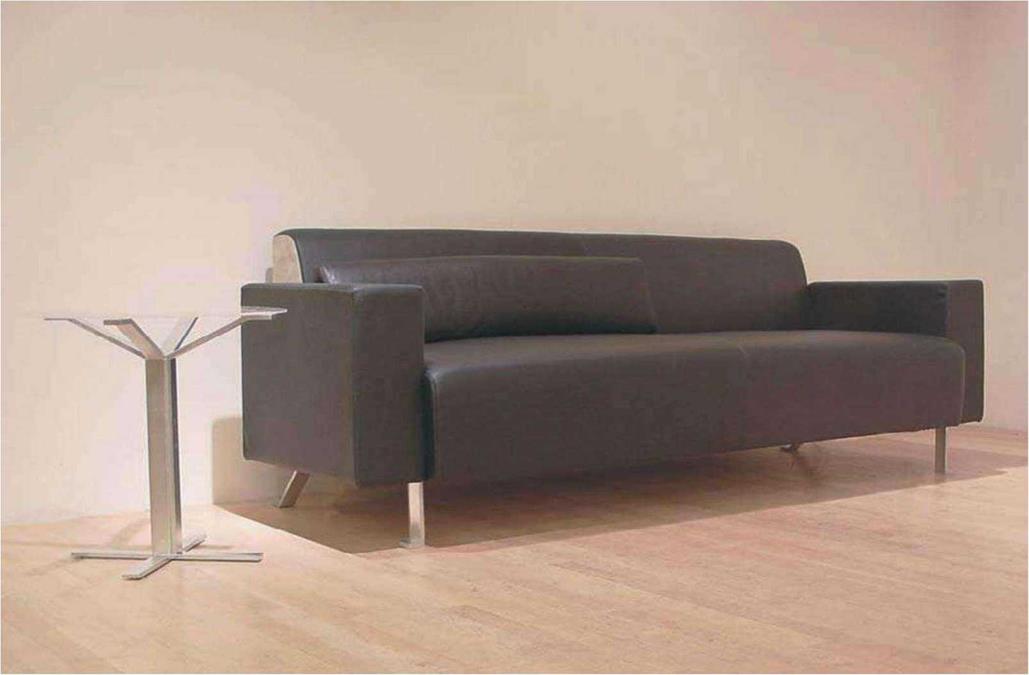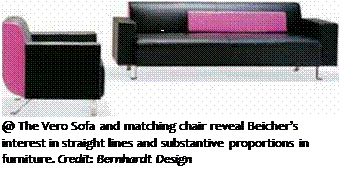 “I wanted something modern and classic, that also went back to the history of modern design, the roots of geometry, the pure shapes of a square, triangle, and circle.” He managed to achieve this tall design order by a somewhat surprising focus on simplicity. “I wanted something that was calm, almost banal, and yet precisely designed.”
“I wanted something modern and classic, that also went back to the history of modern design, the roots of geometry, the pure shapes of a square, triangle, and circle.” He managed to achieve this tall design order by a somewhat surprising focus on simplicity. “I wanted something that was calm, almost banal, and yet precisely designed.”
The Vero uses a series of straight lines and substantive proportions combined with two very judiciously used quarter-circles and some slender angles to create the desired aesthetic. “When you look at the front of the piece,” says Biecher, “it’s just blocks. But when you look at the side, you can see the curving angles at the top and bottom of the back. All of this is resting on legs set at a perfect 45 degree angle, so it’s almost fragile.” Biecher continues: “I like a sofa that is clearly detached from the floor. I like to have the space breathe around the piece. Then, to complete the whole thing, there is this use of color and texture that is showing the thickness and substance of the piece.”
After considering it, then rejecting it, Biecher ultimately decided to include a long, low pillow bolster as a little element of comfort that gives some relief to the precision of his overall design. “My work is always a little bit stiff,” he says. “I don’t like soft things. I like straight things, something that holds itself.” Of the pillow, he points out, “It’s a little plus. It makes the sofa a little more sexy for those who might otherwise find it too strict.”
Some of this adherence to the clarity of pure form perhaps stems from Biecher’s background as an architect. “Probably there are certain shapes, color, and vocabulary that you can see in my work,” he allows, “even though I try to forget that I am an architect when I go to design a spoon. Somewhere, I know that even if I think it’s not the same type of work, these different skills are unified in a vision of the world, of what we can have. It’s a way of looking at things, wanting to redesign the things that are around us, the chairs, the lamps, the buildings, the city.”
Biecher begins his process of redesigning the world in his sketchbook. For the Vero, he remembers the design began with a chair. “I didn’t even like the chair, I didn’t like the proportion, but two pages later, it was immediately turned into a sofa. It still had the idea of the chair because the geometry didn’t change.” He then moved to the computer to work on proportion and other details. He tried both metal and upholstered armrests, but found the metal ones “scary” and so opted for the greater substance and comfort of upholstery.
Initial prototypes were made in plywood and white fabric. Primarily, they were used to find the right size for the armrests. “It was ultimately a sense of balance,” Biecher says. “The piece had to look comfortable and inviting.” Looking back, he reports that develop-
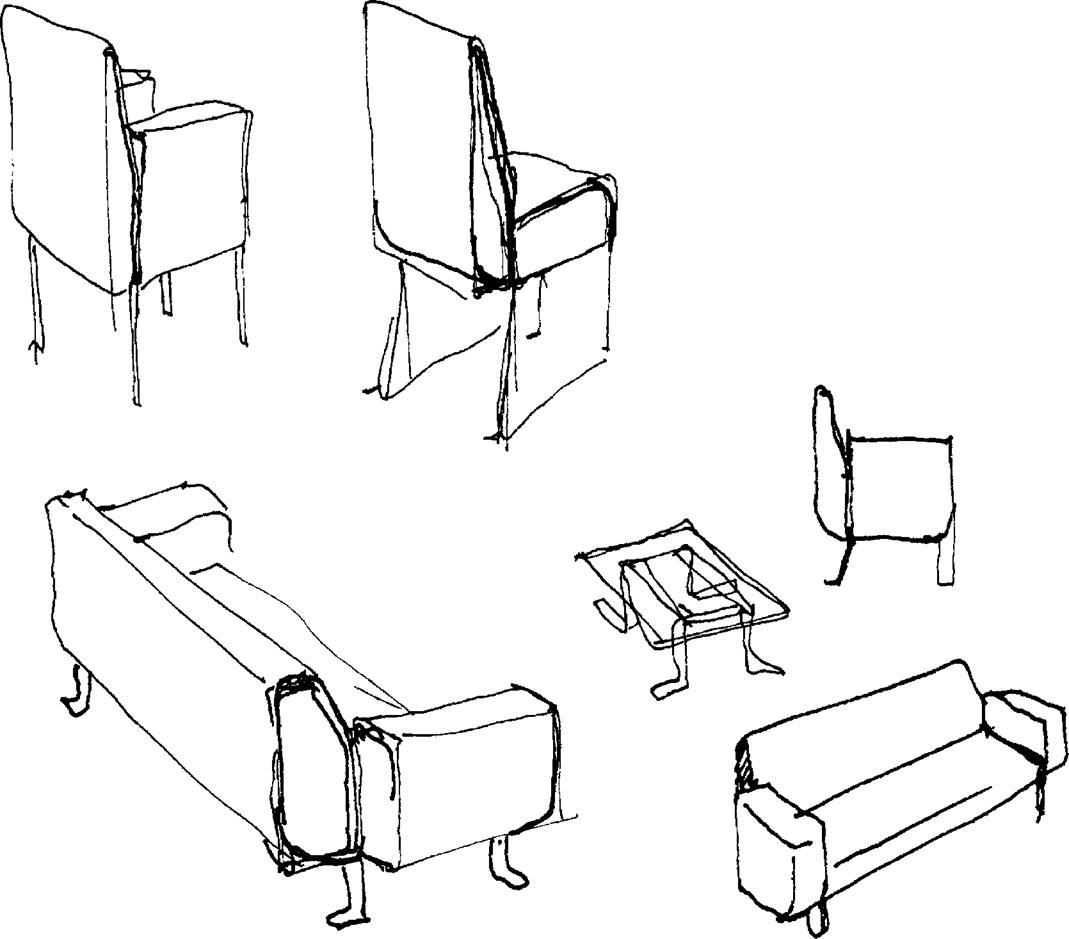
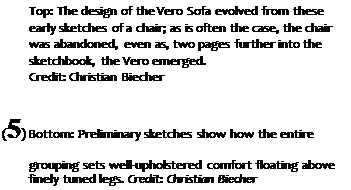 merit went quite smoothly. “Structurally, it’s always calculated,” he says. “The seat part, the bottom part of the sofa, it is quite thick, so it’s easy to have it rigid. It’s like a little bridge. The thicker it is, the more structure it has. Then the legs have to be strong enough in terms of the thickness of the steel. But it’s very simple, technologically speaking.”
merit went quite smoothly. “Structurally, it’s always calculated,” he says. “The seat part, the bottom part of the sofa, it is quite thick, so it’s easy to have it rigid. It’s like a little bridge. The thicker it is, the more structure it has. Then the legs have to be strong enough in terms of the thickness of the steel. But it’s very simple, technologically speaking.”
This contrast between the delicacy of the legs and the substance of the overall piece is particularly pleasing to Biecher. Not only does he “. . . like the idea of a heavy piece floating on fragile supports,” but he also wanted to veer away from the coldness of some modern design. “Most of the contemporary pieces that are sleek are also very anorexic. I want my work to be friendly, but designed. My work has flesh, and I like that. I want my pieces to be sensual, not anorexic. Anorexic is a negation of the senses.”
Biecher ultimately decided to create a companion table for the sofa. “At first, I designed something that was beautiful in sketches, but very ugly in 3D,” he says. Then, looking back at some earlier
drawings, he found a shape that pleased him. “I’m very happy with this table. It has the silhouette of a martini glass, with straight legs and a triangle that holds a circle. It allowed me to express, with the minimum of materials, something that I love, something that I want in my own house. I love it because it is far from any design gesture; it is just essential and sculptural.”
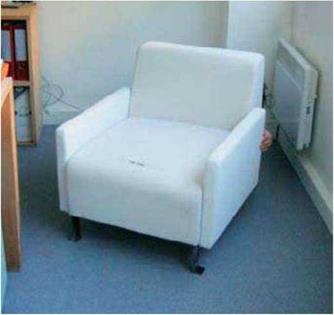
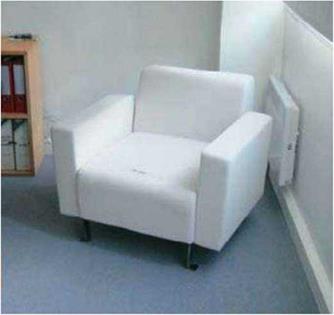 The Vero and its accompanying chair and table can take up comfortable residence in a variety of settings. “In the office,” Biecher muses, “I see it in a lounge or waiting room. I could see it in a bar, or a restaurant, or a store. At home, this is also the type of seat I like to have because it is comfortable and a place where you can have conversation with your friends.” He notes that although the Vero is usually shown by the manufacturer, Bernhardt Design, in strong contrasting colors, it is a piece that can take on a wide range of personalities. “In black leather, it is very corporate. If you upholster it in flowers or color, it looks very domestic,” he says. “It was presented at a furniture fair in tweed and suede and it looked very James Bond. I love it even in flowered chintz.”
The Vero and its accompanying chair and table can take up comfortable residence in a variety of settings. “In the office,” Biecher muses, “I see it in a lounge or waiting room. I could see it in a bar, or a restaurant, or a store. At home, this is also the type of seat I like to have because it is comfortable and a place where you can have conversation with your friends.” He notes that although the Vero is usually shown by the manufacturer, Bernhardt Design, in strong contrasting colors, it is a piece that can take on a wide range of personalities. “In black leather, it is very corporate. If you upholster it in flowers or color, it looks very domestic,” he says. “It was presented at a furniture fair in tweed and suede and it looked very James Bond. I love it even in flowered chintz.”
Ultimately, Biecher sees himself as having created something that is adaptable to a wide variety of locales, atmospheres and users. “I don’t want to design pieces that give lessons or dictate an attitude,” he states. “I don’t want pieces that tell you how to dress or to be. I want to design open and user-friendly pieces.” He reflects: “It’s ultimately not up to me to define my work, but I know the things I’m attached to.”
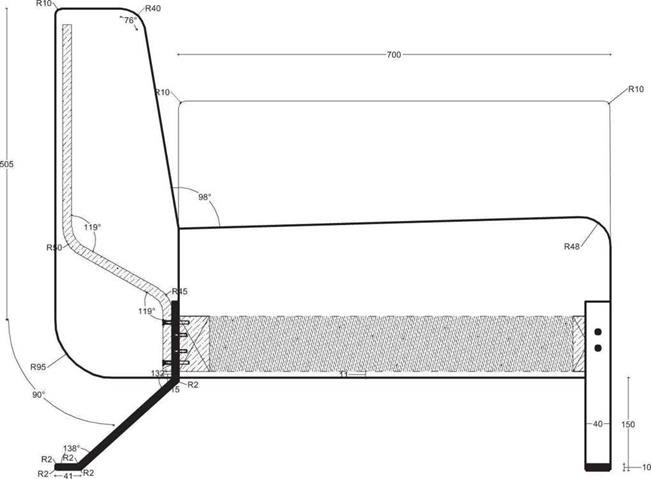 |
900 t
|
162 DESIGN SECRETS: FURNITURE |
|
© Opposite top: Two prototypes reveal how the thickness of the arms creates a dramatic difference in overall balance and proportion. The designer notes that he prefers a designed sensual piece that has substance over the more contemporary “anorexic” designs. “Anorexic is a negation of the senses.” Credit: Bernhardt Design
@ Opposite bottom: Computer renderings show the clarity of geometric form that was Biecher’s predominant design interest. Credit: Christian Biecher
Shaped like a piece of fine, glass tableware, an accompanying table offers delicate balance to the generous form of the Vero Sofa. Credit: Bernhardt Design
<2> The strict lines of the Vero are enhanced by the drama of contrasting colors, even as they are softened by the long, low bolster pillow. Credit: Bernhardt Design
![]()
